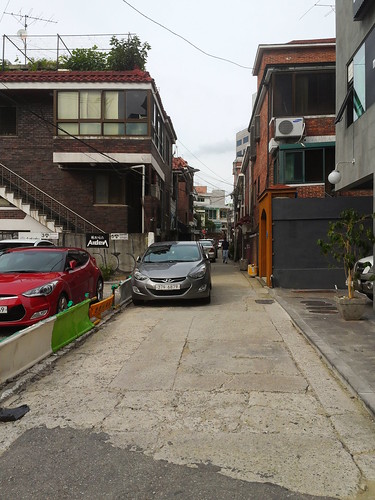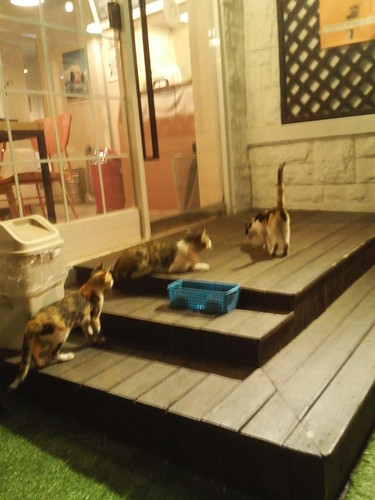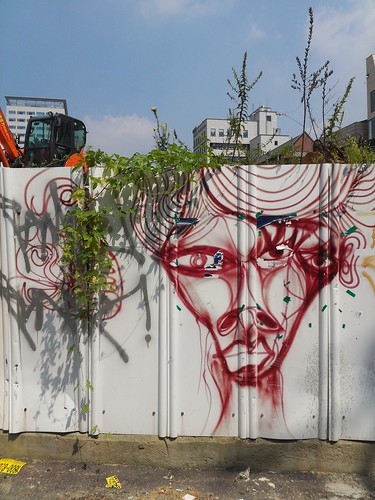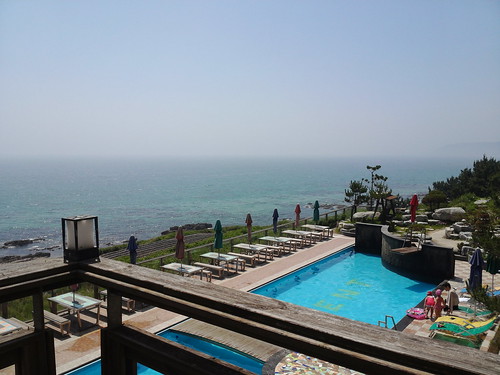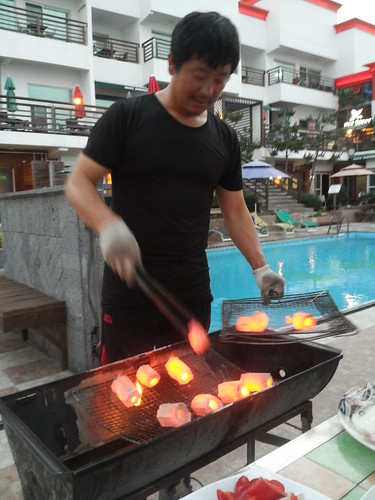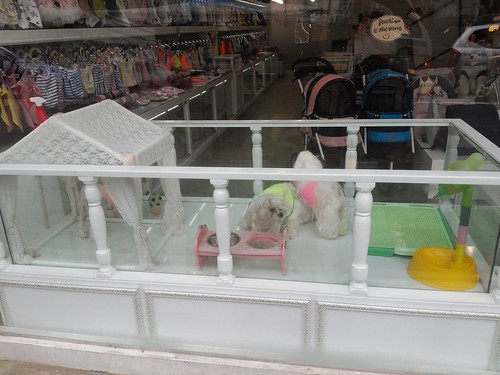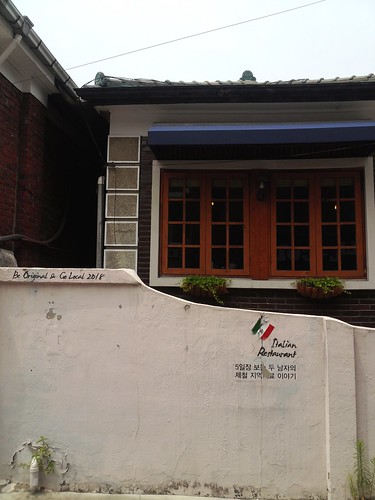#HappySeoul is the tag for a cover of Pharrell William’s Happy. In the video, expats and locals dance through a sun-kissed, verdant Seoul. Watch it because everyone in it is happy:
Thematically, shots of happy kids follow on from writhing girls in short-shorts. In the last shot, what appears to be a pregnant woman gets Happy Seoul written across her belly. Even her fetus will be happy. Seoul is hot… it’s cute… it’s heart-warming and family-oriented. Through jarring juxtaposition, #HappySeoul is all things to all people. What’s wrong with this picture?
1: this is not Seoul.
The video lacks smokers around every corner, people spitting on the sidewalk, and constant traffic, as Korea’s full-sized sedans perform their own dance of the machines along tiny sidestreets. Seoul is not this quiet and does not have this much public space: the city has 8% green space, the lowest of any big city in the developed world. Seoul is mainly huge roads and blocks of indistinguishable apartments that go on for miles.

Dance in this traffic – the street next to #HappySeoul’s BMX riders.

Dance in this smog – the spring dust storms from China combine with Seoul’s choking fumes to block visibility.

Dance in these crowds – Friday night in Hongdae.
The video’s lithe, expat dancers unintentionally reflect the pressures of the western labour markets: many ESL teachers have a fine arts background and can’t find work in their own countries. But if you come to Seoul, you will not find midriff-baring subway dancers or bikini-clad young women hanging out in the reclaimed river. Korea is conservative. There are many beautiful and sexy people in Seoul, but as I’ve pointed out, this is largely due to the brutal, unrelenting quest for status. The dancers posing in front of the Han, or in the Haebangchon underpass, could only strike those poses due to years of hard work and practice. Their apparent leisure is a product of Korea’s punishing work ethic.
In short, Korean society is not happy. There are many good social indicators of this fact. In the OECD, Korea has:
– the highest suicide rate
– the highest elderly poverty rate (and, relatedly, suicide rate among the elderly)
– the second-longest working hours and the lowest productivity
– the highest per capita rate of plastic surgery in Asia
If you visit the neighbourhoods featured in the video (I live in one of them), you will see happy people. But you’ll also see evidence of the above statistics. So what is this video actually saying?
2. Just because you say something doesn’t make it so
The response by the filmmakers and commentators to these points has been instructive. For example:
-Wow! You witnessed all that beauty and “Happy” and THAT is what you come up with??? That actually says more about YOU than the Korean people… Just watch the video again & have a “Happy” day.
-whatever the reason is, they made this video to share happiness, so don’t fight over records and such, be happy for whatever there is to be happy about right now.
-Actually this is seoul to the fullest. A few of my friends were in this video (worked on it too) and it was all done on a volunteer basis. Peopled turned up and just danced around on camera for free. Unless you were there during the shooting of this project please have several seats because you know nothing about Seoul.

Han on display – art in Hongdae
Pointing out #HappySeoul’s inaccuracy means succumbing to pessimism, projecting your own jaundiced perspective on the dancing masses. And even if there are some statistics suggesting otherwise, why point it out and make it worse? Be part of the solution rather than the problem.
But this isn’t the correct way to pose the question. It’s not about how optimistic or pessimistic you are, it’s whether the image you create has any relationship to reality. And if the city in #HappySeoul has a tenuous link to the real Seoul, what purpose does making a video like this serve?
The video captures one truth: Korean people are friendly and gregarious. You can’t sit in a cafe without at least one group of young women nearby, clapping and laughing. It’s common for Korean women to playfully slap their boyfriends. Korean social norms are expressive. But this video is all jeong and no han; as I argued in my last post, Korean society is equal parts solidarity and sorrow. This is not just an abstract statement: it’s constantly on display in the shouting, shoving and arguments that are part of pedestrian traffic here. The middle-aged men spewing complex colour palettes on the sidewalk after a night of company-enforced drinking are neither happy nor dancing.

There are bikini-clad women in Seoul, inexplicably advertising drumming lessons.
At best, a video full of happy people in an unhappy city is an attempt at reframing. There’s some truth to the cognitive therapy adage that if you find positive aspects of a bad situation, you can feel more hopeful and gain the strength to change it. But that only works if your circumstances are amenable to changing. The fatal flaw of cognitive therapy is that for those people in circumstances or structures well beyond your control, the reframing collapses in on itself and becomes a new way of self-blame. And that’s the conclusion commentators have drawn: if you can watch this video and not be happy, there must be something wrong with you. Which is a message that fits very well with neoliberal ideology: bootstrap yourself into a career, security and happiness. If you can’t do it, try harder. Those who have ‘made it’ have no responsibility to explain their rose-tintedness. They are free to blame the losers – and because there are winners, there must be losers.
At worst, this video is an active, if unwitting, obfuscation of social reality. What is a denial of very real social problems, from state repression to inequality, but a kind of sociopathy, an unwillingness to see the suffering on display on the streets of Seoul? It becomes propaganda, disturbing because of its very banality. The everyday of Seoul is dancing and smiling, it says. Come spend your money to experience it. Those who don’t fit don’t exist. They are the cracks in the pavement that our happy dancing will stomp on.

Yeonnam-dong’s own grumpy cat – if you’re pure-bred, you’re valuable enough to be kept on a leash.
Suffering is not motivational. Ripping the veil from people’s eyes doesn’t make them want to change it. This video resonates because it fills a need: people want to be happy, and to imagine a place where happy exists. This is fine in a Disney film, or in one of the giant theme parks that are so popular here. There’s no illusion about the escapism on offer in a theme park. But I think extending that narrative to an entire city is a form of violence. It denies the complex reality of 24 million people struggling to sell themselves in order to survive. #HappySeoul is not a story of redemption, of people facing challenges and learning to overcome them, or – god forbid – failing and learning about themselves. It’s an erasure of those struggles, an aestheticization of politics, like Benjamin warned us about. Given that it was made largely by foreigners, for foreign consumption, it even flirts with orientalist notions of happy Koreans, echoing similar images produced under Japanese occupation.

Not the Paris Commune – the ‘commune of radicals’ stripped of meaning and used to sell designer clothing.
For that reason, #HappySeoul accomplishes what it sets out to do: display a metropolis of smiling, carefree extroverts. And it accomplishes a darker purpose its makers may be unaware of: it disappears the conflicts and pain that make Seoul a real, vibrant, difficult place to live. #HappySeoul is propaganda that Koreans themselves have disavowed. Even mayor Park Won-soon doesn’t want Seoul portrayed this way: as he explained upon commissioning the video Bitter Sweet Seoul,
“Seoul has a sad history. If we try to project only the good side, it’s not the real thing,” Mr. Park said.
“Seoul is not a place in monotone; It has so many different colors… Having it depicted through this film will ultimately help attract more tourists,” the mayor said.
What does depicting Seoul with only one colour accomplish?









